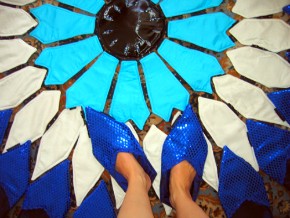Wearable worship

Years ago I was part of a new church that was meeting on Sunday evenings in the basement of a language school. The minister, Liz Myer Boulton, would show up in the late afternoon with what she called “church-in-a-box.” Out of the big plastic bin that she carried around in the trunk of her car would come an altar cloth, candles, a Bible, a cross, and a cup and plate for communion. In half an hour or so, the basement would be transformed into sacred space, ready to welcome a congregation. With her box, Liz traveled light, ready to move as the spirit moved. Liz and her box could make a church almost anywhere.
Sarajevo-born artist Azra Akšamija has explored the notion of portable worship by creating “wearable mosques.” Her Nomadic Mosque is a woman’s suit of clothes that can be opened and unpacked to provide the wearer with a head covering, a prayer rug, and a compass to find the direction of Mecca. The wearer of Nomadic Mosque can pause anywhere to pray. Akšamija’s work makes a place in the secular spaces of the world for Muslim prayer and shows a religious tradition moving through time and space, transforming the world around it and being transformed as well.
In her discussions of her wearable mosques, Akšamija often refers to the hadith, in which the Prophet Muhammad speaks of how the whole world is a mosque, made so by prayer and not by architecture. Her multipurpose suit of clothes is also a reminder that a mosque is a world—a place not only for prayer, but also for learning, resting, discussing, and gathering with a community. Akšamija’s wearable mosque makes Muslim devotion and Muslim life visible in a society where Islam is often misunderstood and threatened. Another of her wearable mosques, Survival Mosque, comes equipped with an American flag for the wearer to display, along with earplugs to block out the sounds of shouted insults and a cleaning solution in case someone spits on the wearer as she prays.




